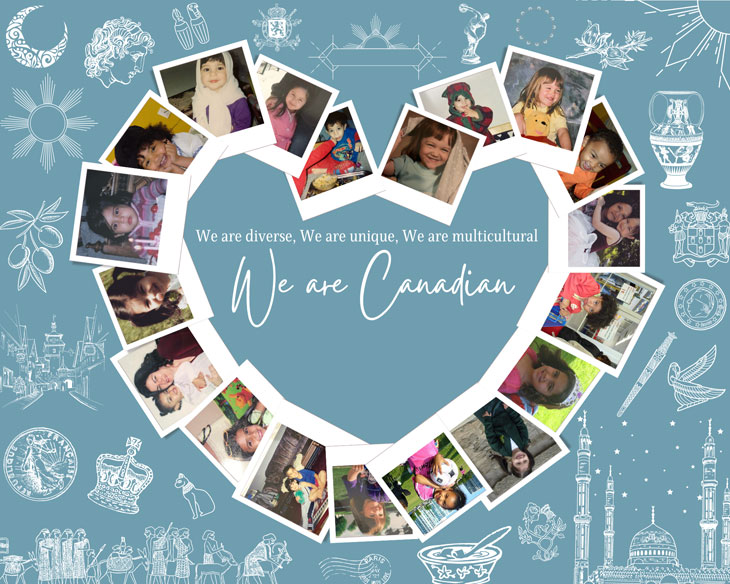We use cookies on this site to enhance your experience.
By selecting “Accept” and continuing to use this website, you consent to the use of cookies.


Our aim with the infographic was to reflect on our inclusivity concerning our backgrounds and identities. We created a collage to show our physical differences and stress how there is no particular “look” to Canadians. Despite our differences, we focus on what brings us together rather than what divides us. We chose childhood photos to symbolise the beginning of our intercultural journeys. Through our union, we discussed significant issues that allowed us to see all the things we have in common and admire about one another. Another creative aspect of our poster is the symbolic cultural images within the background. For instance, we incorporated a Palestinian olive branch, the Philipino sun symbol, Greek statues, and European crescents. Our infographic shows the unconventional ways we make up Canada.
When we started our LICC discussions, we recognised that we are diverse. Now that we’ve concluded our workshops, we can begin to apply the lessons and techniques we’ve learned. To better understand the importance of diversity and how it makes us uniquely Canadian, we shared many of our unique upbringings and curiosity for one another. Our relationships with our peers and family members also play a significant role in the perspective we carry in our lives. The guest lecturers played a considerable role in our new views of multiculturalism. Mike Boylan taught us to look beyond stereotypes and assumptions when interacting with others. Ben Yang introduced us to the true meaning of multiculturalism, leaving us with a new definition of Canadian culture and making us realise there is always more to learn. Lauren Burrows exposed the hidden characteristics of white supremacy, forcing us to analyse those around us and our possible contributions to perpetuating white supremacy. Jane Desmond taught us a valuable lesson in intercultural communication and how important it is to remain patient and open-minded. Finally, Anne-marie concluded our learning by teaching us about an intercultural praxis model and how our previous workshops contributed to one another.
Our LICC discussions incorporated different workshops we participated in throughout the course. The guest lecturers presented us with stimulating concepts and skills that we applied in our conversations with Sirisa Pria, the international volunteer student from Thailand. A powerful theme mentioned in many lectures was communication and how we can navigate it in a multicultural society. We found that multicultural communication can be demanding as you have to consider the differences between your cultural practices and the cultural norms of others. For example, in an activity where we shared a pen with another student attempting to recreate an unknown object, we noticed the necessity of clear communication. It is easy to assume that another person will understand you, especially if there isn't space or means for them to ask you for clarification. Likewise, another corresponding lesson was understanding each other's traditions, norms, and values. For example, we watched a short clip of a British man eating with his Chinese colleagues in which he aimed to be respectful but crossed their boundaries, generating conflict with cultural norms. From this, we realised that although we assume we are being respectful, it might not align with the cultural standards of another. Proper communication requires reflection upon privilege, especially with other cultures, religions, and ethnicities. Privilege affects how we interact with and view other people, especially in a county with a dominant white society. By reflecting on our past discussions, we realise the interconnection of these elements and the measures we've taken to understand interculturalism.
We found that being sheltered plays a significant role in our views. We are each sheltered by the world in our ways, which aids in applying our learnings to the 'real world.' Whenever we thought we had reached an intercultural mindset, we came across many things that proved us wrong. We discovered self-reflection and how to re-evaluate how we interact with one another. Furthermore, we learned to question why we perceive the world in the ways we do and how we can expand upon those preconceptions. While we value and accept one another, it doesn't erase our differences. Through these interactions, we found that cultural norms are easier to disregard in practice than in theory. It is only easy to truly step out of your mindset if you actively do so. We are constantly practising implementing our newly established skills to navigate cross-cultural communication. These meetings revealed how we could expand our understanding of multiculturalism.
Zeina Ayoub, HR 261, Human Rights Human Diversity, Brantford
Jasmine Brown, HR 261, Human Rights Human Diversity, Brantford
Thea AuCoin, HR 261, Human Rights Human Diversity, Brantford
Michaela Rawlingson, HR 261, Human Rights Human Diversity, Brantford
Anisa Sakaji, HR 261, Criminology, Brantford